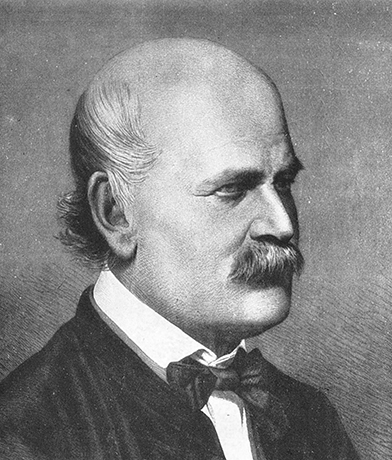| << Chapter < Page | Chapter >> Page > |
In 1847, Hungarian obstetrician Ignaz Semmelweis ( [link] ) observed that mothers who gave birth in hospital wards staffed by physicians and medical students were more likely to suffer and die from puerperal fever after childbirth (10%–20% mortality rate) than were mothers in wards staffed by midwives (1% mortality rate). Semmelweis observed medical students performing autopsies and then subsequently carrying out vaginal examinations on living patients without washing their hands in between. He suspected that the students carried disease from the autopsies to the patients they examined. His suspicions were supported by the untimely death of a friend, a physician who contracted a fatal wound infection after a postmortem examination of a woman who had died of a puerperal infection. The dead physician’s wound had been caused by a scalpel used during the examination, and his subsequent illness and death closely paralleled that of the dead patient.
Although Semmelweis did not know the true cause of puerperal fever, he proposed that physicians were somehow transferring the causative agent to their patients. He suggested that the number of puerperal fever cases could be reduced if physicians and medical students simply washed their hands with chlorinated lime water before and after examining every patient. When this practice was implemented, the maternal mortality rate in mothers cared for by physicians dropped to the same 1% mortality rate observed among mothers cared for by midwives. This demonstrated that handwashing was a very effective method for preventing disease transmission. Despite this great success, many discounted Semmelweis’s work at the time, and physicians were slow to adopt the simple procedure of handwashing to prevent infections in their patients because it contradicted established norms for that time period.

Around the same time Semmelweis was promoting handwashing, in 1848, British physician John Snow conducted studies to track the source of cholera outbreaks in London. By tracing the outbreaks to two specific water sources, both of which were contaminated by sewage, Snow ultimately demonstrated that cholera bacteria were transmitted via drinking water. Snow’s work is influential in that it represents the first known epidemiological study, and it resulted in the first known public health response to an epidemic. The work of both Semmelweis and Snow clearly refuted the prevailing miasma theory of the day, showing that disease is not only transmitted through the air but also through contaminated items.
Although the work of Semmelweis and Snow successfully showed the role of sanitation in preventing infectious disease, the cause of disease was not fully understood. The subsequent work of Louis Pasteur , Robert Koch , and Joseph Lister would further substantiate the germ theory of disease.
While studying the causes of beer and wine spoilage in 1856, Pasteur discovered properties of fermentation by microorganisms. He had demonstrated with his swan-neck flask experiments ( [link] ) that airborne microbes, not spontaneous generation, were the cause of food spoilage, and he suggested that if microbes were responsible for food spoilage and fermentation, they could also be responsible for causing infection. This was the foundation for the germ theory of disease.

Notification Switch
Would you like to follow the 'Microbiology' conversation and receive update notifications?